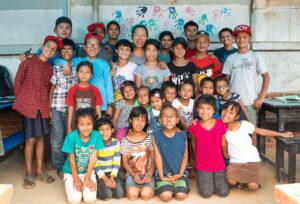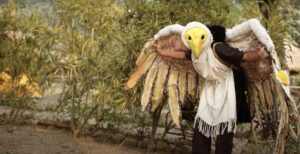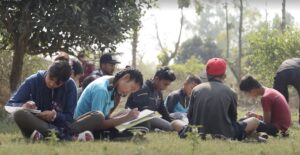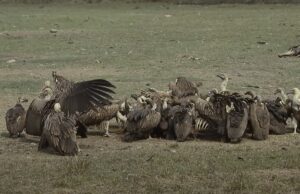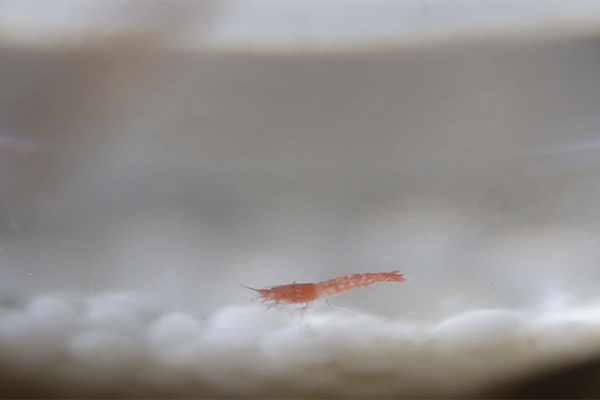Gauri Kasarla is a 2023 Navab Fellow from Columbia University studying Art History and Visual Art. She spoke with 2023 CAF grantee Namita Kandel of The Jane Goodall Institute Nepal. The interview has been edited for length and clarity.
Gauri Kasarla: What drew you to helping produce a play about vultures?
Namita Kandel: The idea of a theatre to educate people about endangered beings started with a protest in 2019 to save the last native hardwood forest of Nepal, the municipality of Nijgadh, and along with it, the eight species already endangered but vital to the various ecosystems across Nepal. Pangolins, forest leopards, Asiatic elephants, river dolphins, brown bears, spiny babblers, vultures, and bumblebees are recognised as Anautho Aath, which translates to the “Incredible Eight.” A campaign to protect them developed out of a loose collection of institutions and organisations called People’s Alliance for Nature Nepal, of which Jane Goodall Institute Nepal (JGIN) and Children and Youth First: Life vision Academy (CYF) are a part.
JGIN helps organize and source support for the project, which is mainly being run by CYF. I am responsible for the logistics, as well as resource and art curation, for the plays and workshops. So if there’s some kind of research needed, I make sure that researchers, theatre artists, ornithologists, and conservationists, who have been with us in protecting the forest, can assist.
Gauri: What is the attitude towards vultures that you hope to change in Nepal? And why do you think that attitude persists?
Namita: Okay, I’ll answer the second question first. The attitude persists because of the word we use in Nepali for vultures: gid’dha. And gid’dha has a very negative connotation. Let’s say somebody is teasing you on the streets. It’s called gid’dha nazar, like you’re watching me through the vulture’s eyes as meat to scavenge. That negative connotation I want to change. Vultures are scavenging for the meat that is going to rot, spread disease, and ultimately lead the disease to you, as a human. So, if vultures are not there, the actual threat, or gid’dha nazar, is present rather than the other way around.
The word’s negative meaning veers towards the birds themselves, even though vultures, as a species, are valued in mythology and cultural memory. One of the plays we performed in February 2023 was in Dhanushadham, where one of the great Hindu epics, the Ramayana, partially takes place. In the Ramayana, Rama, the hero, goes on a long journey to rescue his wife, Sita, from the demon king Ravana. There, the idea of vultures is really positive because they fly to save Sita. But because the bird itself is huge and very menacing-looking, it’s not in our recent cultural memory.
Gauri: That’s really interesting you mentioned the Ramayana because birds are very important to the whole plot and the narrative logic.
Namita: Yes. We perform these plays, and conduct workshops and story-writing in rural areas, and the local population don’t have the scientific data to say, “Oh, the birds are extinct.” But we can talk to them through the lens of cultural importance, to bring them into the fold of conservation—through mythology, through cultural memory, through even the memories of the older folks. We’ve gone to places where the memory of vultures is quite fresh, in the sense that the vulture population plummeted only about twenty years ago. So, older folks in those places still have memories of seeing vultures in abundance around their community and in their forest—literally seeing them scavenge. I’m from the capital, Kathmandu, and I know I used to be able to see vultures around, but now it’s not so common.
As we go into the communities, we hear individuals’ stories and are incorporating them into the plays. In evoking that cultural memory, we can change the perception of vultures and change the way we dispose of carcasses and dead cattle, because everything is interconnected. In the Terai region in the southern part of Nepal, there’s a vulture-feeding center called Jatayu restaurant (which means “vulture”). It’s managed by the community itself. Nearby, there’s a community forest, and they run a programme where cattle carcasses for the birds are brought in and checked to make sure they haven’t been fed with nonsteroidal anti-inflammatory drugs (NSAIDs). The human development of medicine for cattle meant well: it helped the cattle not feel pain. But it also led to kidney failure in vultures and a dramatic decline in their population.
Gauri: How are the plays being received?
Namita: We’ve already had six different shows, funded by different entities. The first was in September 2022; the second was in an exhibition organised at one of the engineering colleges here. It was called “Riot Through Conservation.” The target group was young adults and visual art, musical, and theatre audiences. The exhibition challenged notions of what’s socially acceptable and what’s not—all the taboos: kind of like an act of anarchism. Conservation is a form of anarchism against the capitalistic structure that feeds the destruction of things around us—whether it be art, gender, conservation, animals, habitats, the air, everything. We felt, or rather the mentors felt, that the college was the perfect place to stage the exhibition.
It’s not just me doing this work. The plays came together as part of another series of workshops where research for an exhibition on vultures was going on, led by students themselves, and mentored by Haushala Thapa, the founder of Children and Youth First. She brought together the plays more structurally. There’s a group of mentors who interact with the children in the theatre group; I travel with them, sit down with them, and everything. We’ve taken the theatre to places where vultures are still prominent and collaborated with the conservation efforts in the locality.
Gauri: How exactly does the declining population of vultures impact Nepal’s ecosystems?
Namita: More than fifty percent of Nepal is very hilly, so it’s difficult for farmers to dispose of dead cattle. In the past, it was easy for farmers to do this without much hassle because the population was smaller, and the forests were much nearer. As time passed, and the population increased and access to forests decreased, the forest community started placing restrictions on the disposal of cattle carcasses, and many open spaces were used for other purposes. (The cattle weren’t just thrown out in the open; they were buried.)
The people doing the conservation in the field are changing the way cattle are being treated and making sure the forest has enough animals so that vultures can feed on their carcasses when they leave them. If there’s a healthy number of animals in the forest, there’s going to be a healthy number of birds in the skies, as well. Forest animals, like deer and buffalo, sometimes roam into open spaces, where they can become prey, and their bodies visible to vultures. The absence of cattle and wild animal carcasses leads to fewer vultures. With fewer vultures, the improperly disposed of cattle carcasses just rot, creating more disease—potentially among stray dogs, who may eat them. In turn, stray dogs may be illegally poisoned by people to stop rabies infections or to prevent their population growth. If the dogs’ bodies are in turn not disposed of properly, vultures can become sick from scavenging their flesh.
In this way, the declining health of the forest and micro-ecosystems has affected the entire community. We are trying to break that cycle through an awareness campaign.
Gauri: So, do the plays contain explanations of this cycle as a form of awareness?
Namita: They contain all these stories. The new play right now is forty-five minutes long and we’re taking the script and adding, editing, and updating information from communities that we either got wrong or are making more accurate.
For example, one audience member aptly said that reading about the declining vulture population in a book would not be registered in the minds of people as much as it would be when watching and engaging emotionally and visually with the content of the play. So, we should get facts and figures exactly on the dot, so people can retain that information and then take the conservation chain forward by themselves.
Gauri: How does your work with Roots & Shoots mesh with your play?
Namita: The basic ethos of the programme and my work is to empower young people with information and knowledge and the overlapping connections between nature and society, so they understand where and how to create a healthier road for everybody. This theatre idea is also taken to schools by JGI under the Roots & Shoots programme, where schools choose a species and either make a play or write articles about it to showcase their research.
There are nine species of vultures found in Nepal. Some are residents, some are migratory; but nine species are always around. These species were assigned to nine different groups of students, and they researched them by themselves. When the conservationists came to the students for a session, they had an in-depth conversation about not just their data, but the interconnections of the environment and our activities.
So, the students weren’t just learning about the vultures, they were learning about the interconnections, our policies, how a local person getting NSAIDs for their cattle from their veterinarian can cause all of this—without any conscious decision to destroy culture or population. It’s unintentional, but impacts all of us.
We’re empowering people to use knowledge in whichever direction they might want to go. So, my formal work and conservation theatre go hand in hand. I have since started wrapping up my involvement in Roots & Shoots. My work with the theatre is now heading towards a story that will be written in three languages: Nepali, English, and Maithili. JGIN is helping with the students, artists, the exhibition, story-writing, and designs of the workshops.
Gauri: Thank you so much!



